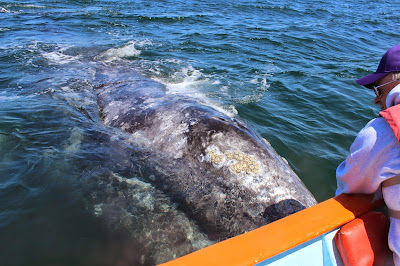By
Kristy McCaffrey
“This species of whale manifests the greatest
affection for its young…”
~ Charles Melville Scammon, 1874
 |
| Look behind you...a gray whale wants to say hello. |
In
early April, I had the opportunity to visit Laguna San Ignacio, an inlet
located on the Pacific coast side of Baja Sur California, Mexico. A remote,
undeveloped area with miles of salt flats, it boasts one of the most amazing
interactions happening today between humans and wildlife. It’s here that Pacific
gray whale mothers bring their calves directly to small skiffs, introduce themselves,
and visit. Touching the slick and rubbery skin is a given, but if you’re lucky you
can plant a kiss on a whale snout, or perhaps run a hand along the baleen when
a whale opens its mouth for you.
 |
| A Pacific gray whale calf. |
 |
| A gray whale calf with my Uncle Kevin. |
 |
| A gray calf with my dad, Rick Kearney. |
 |
| My mom makes contact with a baby gray whale. |
How
did this come to be?
In
the latter part of the 1800’s, gray whales, known as “devil-fish,” were
considered extremely dangerous. Within Laguna San Ignacio, an American whaling
fleet led by Charles Melville Scammon slaughtered hundreds—the lagoon a haven
for the whales to mate and give birth each winter. Scammon, a daring and
innovative whaler who became the first Western man to find a safe passage into
the inlet, was, without a doubt, responsible for bringing the gray whale to the
brink of extinction. Ironically, he has also greatly influenced what we know
about the creatures today, with his meticulous documentation of the grays’
migration patterns, anatomy, and behaviors.
 |
| Charles Melville Scammon. |
 |
| Rendering of a gray whale. |
 |
| A Pacific gray whale mother approaches the boat. |
In
1972, however, a new relationship was forged between man and mammal. A local
Mexican fisherman, Pachico Mayoral, was in his skiff in Laguna San Ignacio one
February day, fishing for grouper, when a gray whale surfaced beside him. He
was, understandably, fearful. But after a time, when the animal didn’t leave,
he felt compelled to put his hand into the water. The whale rubbed against him.
And so began an unprecedented communion between humans and whales.
 |
| A baby gray beside its mother. |
Coincidentally,
it was during this time that the Mexican government decreed the San Ignacio Lagoon
habitat a refuge for migratory birds and wildlife. The same year, the United
Nations voted for a resolution calling for the end of worldwide whaling and the
U.S. Congress passed the Marine Mammal Protection Act. In 1973, the Endangered
Species Act was passed with gray whales on the list; they would remain there
for the next twenty years, leading to a dramatic recovery of the species.
(Unfortunately, gray whales in the North Atlantic have been extinct since the
1800’s, likely due to whaling.)
Why
the whales make contact remains a mystery. Experts believe it’s a learned
behavior, handed down from mothers to calves, though a legend abounds that it
was Pachico who taught them. Dr. Jim Sumich, who has studied gray whales for
decades, says, “Friendly encounters are not gray whale behaviors, they are gray
whale-human interactions.”
Gray
whales, while not the largest of the whale species (blue whales take that
honor), have the longest migration of any animal on earth. During the course of
a year they travel from three warm lagoons in central Baja (in addition to
Laguna San Ignacio, they are also found in Magdalena Bay and Laguna Ojo de
Liebre, although San Ignacio is reputed to have the highest percentage of “friendly”
encounters) to Arctic feeding grounds near the Bering Strait, covering, at a
minimum, 10,000 miles roundtrip. A 30-ton whale will expend enough energy on
the return trip to shed 8-tons of its blubber. Gray whales have no teeth,
rather they feed primarily on tiny, shrimplike amphipods by straining the food
through a fringed curtain of baleen—long bristles made of the same substance as
human fingernails—which hangs from the roof of the mouth.
 |
| Gray whales have the longest migration of any animal on earth. |
 |
| The baleen is visible in the upper jaw. |
 |
| Calf and mom. A mother gray will sometimes support her youngster from underneath, showing off her baby to the appreciative and awe-struck humans. |
Gray
whales, with lifespans anywhere from 55 to 70 years long, reach maturation
between 5 to 11 years of age. Pregnancies last 12-13 months, so females
generally give birth every other year. It’s believed they migrate to the Baja
lagoons as a protective measure to care for their young, although some travel
simply to mate, departing soon after. Orcas, the grays natural predator, won’t
enter the inlets, for reasons still not entirely understood although it’s been
suggested that the shallow lagoon impedes echolocation, thus making the killer
whales too vulnerable.
Grays
hug the shore during their migrations, and as a result have been seen by more
people, in more places, than any other leviathan. The whale-watching
multi-million dollar industry began in the 1950’s, but the grays remained
aggressive toward researchers and fisherman throughout that time, especially in
the lagoon, frequently ramming boats or smashing them with a flick of their
tail flukes.
Only
two whales have ever been in captivity, and they were both grays. In the ‘90’s,
on two separate occasions, gray calves were kept for several months and then
released into the wild.
 |
| A gray whale mother. |
Whale
watching is strictly regulated within Laguna San Ignacio by the Mexican
government. Only twelve boats can be out at any given time, and none are
allowed in the southern inlet, or Upper Lagoon, where calves are nurtured. Only
in the open stretch of the north inlet are the skiffs permitted to approach
whales, but they must remain within a thirty meter radius. And only two boats
may circle any one whale at a time. It’s always the grays’ choice whether to
approach a boat. On windy, choppy days they stay away, because it’s said they
know they would damage the skiffs.
Terry
Marcer, owner of Ignacio Springs Bed and Breakfast (located in the town of San
Ignacio), shared the story of a woman determined to touch a whale one season.
It was January, which is generally not the best time for interaction because
males are more interested in mating and many of the females have given, or are
about to give, birth. As a large whale swam past the skiff, this woman leaned
so far out that she fell into the water. The boat’s driver panicked and sped
away. However, the whale very calmly surfaced, and supported the woman until
the driver gathered his wits and returned to retrieve her.
 |
| It was a challenge to balance taking video and photos while at the same time enjoying their company. |
Homero
Aridjis—author, poet, and Latin America’s leading environmental activist who,
in the year 2000, was directly involved in defeating the Japanese conglomerate
Mitsubishi from extracting salt from the lagoon and thereby saved the gray
whale’s refuge and important birthing habitat—has this to say about
encountering this magnificent beast, “It is a magic touch, a communication of
another kind, beyond species, where you are speaking in some supersensory way.
You can feel them. And you feel they can feel you. How people become
transformed because they touch a whale is inexpressible. You can’t explain
why.”
 |
| Interacting with a wild whale is a life-changing and sacred endeavor. |
On
this April day, I’m privileged to meet several mother-calf pairs, humbled by their
curious and gracious natures. The babies generally arrive first at our 26-foot
long panga, a Baja open boat similar
to a dory, while mom waits in the water just beyond. But soon, she approaches
as well, hovering beneath our skiff, blowing geysers of water onto us. But the
wooing isn’t complete until she rolls to the side and looks me in the eye.
 |
| The eye of a gray whale. |
I’m
spellbound and utterly captivated.
They
remind us what we’ve always known—we are a part of the whales, and they are a
part of us.
And the whales came out
to catch a glimpse of God
between the dancing furrows of the waters.
And God was seen through the eye of a whale.
~ Homero Aridjis
~~~~~~~~~~~~~~~~~~~~~~~~~~~~~~~~~~~~~~~
Works
Cited
American
Cetacean Society. <http://acsonline.org/fact-sheets/gray-whale/>.
Russell,
Dick. Eye of the Whale: Epic Passage from Baja to Siberia. Island Press,
2001.
Wikipedia.
< http://en.wikipedia.org/wiki/Gray_whale>.
Wikipedia.
< http://en.wikipedia.org/wiki/Baleen>.

















